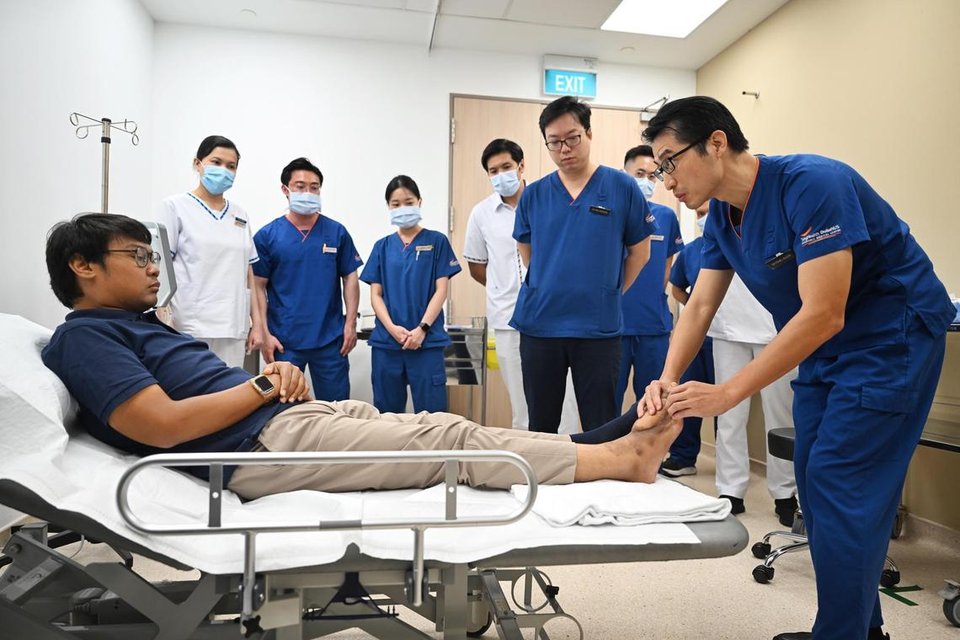More seniors undergo spinal surgery with new minimally invasive, robot-assisted operation

Published on
18 Jul 2024
Published by
The Straits Times
SINGAPORE – After a bad fall in late 2023, Mr Ng Beng Piau was in so much pain that he could not walk more than 300m.
His grandson Nicholas Goh, 34, said: “He likes to travel, but when he went on an overseas trip to China in November 2023, he couldn’t even get out of the hotel.”
After consulting a specialist at Tan Tock Seng Hospital (TTSH) in February, the 85-year-old man was diagnosed with compression of the spinal nerves, a condition common in elderly patients.
It occurs when nerves in the lower back are pinched due to various causes, including age-related degenerative spinal conditions or deformities, resulting in intense pain or numbness.
Mr Ng initially declined surgery after his friends warned him of the risk of spine surgery, especially at his age.
Spine surgery is often perceived as invasive and risky. In standard open-spine surgery, surgeons make a large incision in the back, cutting through muscle and soft tissue. The technique means that patients can take up to six months to fully recover.
But the recently developed robot-assisted minimally invasive surgery offers seniors with spine conditions like Mr Ng a better way to address debilitating pain and improve their quality of life.
Adjunct Associate Professor Jacob Oh, senior consultant and head of spine surgery at TTSH’s department of orthopaedic surgery, said in a media briefing on July 16 that TTSH has conducted more than 120 spinal operations since acquiring the robot-guided spine surgery technology in 2021, the highest among the three public healthcare hospitals that have it.
Before the procedure, using MRI and CT scans, the robot-guided system generates a 3D model of the patient’s spine and allows surgeons to pre-plan their operation by deciding exactly where to place screws on the vertebrae.
When the patient is on the surgical table, the robotic guidance system is able to take an X-ray of the patient and merge it with the pre-operative CT scan to create a 3D model so it can pinpoint with accuracy the position, angle and depth at which screws should be inserted during the operation.
The robotic arm then moves into position, aiding the surgeon in inserting the screws.
This means that surgeons can make incisions as small as 1cm, reducing pain and recovery time for patients.
It also means there is a lower risk of complications like injuring the spinal cord.
Compared with the navigation-only method, where surgeons are able to view in real-time where their surgical probe is but still have to determine on their own the angle and depth for screw insertion, the robot-assisted operation offers more advantages for the patient and the surgeon.
Dr Oh said that according to preliminary TTSH data, robot-assisted spine surgery patients need to stay in hospital for up to two days less, have up to 30 per cent less blood loss, and have a 20 per cent shorter operating time, especially for cases where screws have to be inserted in multiple vertebrae.
In part due to the new robot-assisted technique, TTSH has seen the percentage of seniors opting for spinal surgery jump from 28 per cent in 2018 to 43 per cent in 2023.
“Patients don’t just want to live longer, they also want to be active and independent. Because of the advancement in robotic technology and minimally invasive surgery, our older and frail patients now have an option of going for surgery and no longer have to endure disability,” said Dr Oh.
“Before, people would say it’s not an option, because it can be risky. But now, risks associated with spine surgery are reduced.”
After assurances from Dr Oh and persuasion from his grandson, Mr Ng underwent his operation in April, and could walk about three days after the procedure.
He is now looking forward to a trip to Chiang Mai.
Commenting on his grandfather’s recovery, Mr Goh said: “He is like a free bird now.”
Source: The Straits Times © SPH Media Limited. Reproduced with permission.
ALL views, content, information and/or materials expressed / presented by any third party apart from Council For Third Age, belong strictly to such third party. Any such third party views, content, information and/or materials provided herein are for convenience and/or general information purposes only. Council For Third Age shall not be responsible nor liable for any injury, loss or damage whatsoever arising directly or indirectly howsoever in connection with or as a result of any person accessing or acting on any such views, content, information and/or materials. Such third party views, content, information and/or materials do not imply and shall not be construed as a representation, warranty, endorsement and/or verification by Council For Third Age in respect of such views, content, information and/or materials.







